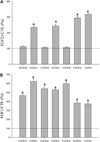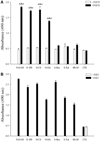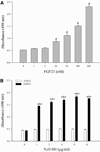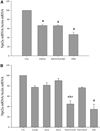Analysis of the biochemical mechanisms for the endocrine actions of fibroblast growth factor-23
- PMID: 16081635
- PMCID: PMC4140631
- DOI: 10.1210/en.2005-0670
Analysis of the biochemical mechanisms for the endocrine actions of fibroblast growth factor-23
Abstract
Fibroblast growth factor (FGF)-23 has emerged as an endocrine regulator of phosphate and of vitamin D metabolism. It is produced in bone and, unlike other FGFs, circulates in the bloodstream to ultimately regulate phosphate handling and vitamin D production in the kidney. Presently, it is unknown which of the seven principal FGF receptors (FGFRs) transmits FGF23 biological activity. Furthermore, the molecular basis for the endocrine mode of FGF23 action is unclear. Herein, we performed surface plasmon resonance and mitogenesis experiments to comprehensively characterize receptor binding specificity. Our data demonstrate that FGF23 binds and activates the c splice isoforms of FGFR1-3, as well as FGFR4, but not the b splice isoforms of FGFR1-3. Interestingly, highly sulfated and longer glycosaminoglycan (GAG) species were capable of promoting FGF23 mitogenic activity. We also show that FGF23 induces tyrosine phosphorylation and inhibits sodium-phosphate cotransporter Npt2a mRNA expression using opossum kidney cells, a model kidney proximal tubule cell line. Removal of cell surface GAGs abolishes the effects of FGF23, and exogenous highly sulfated GAG is capable of restoring FGF23 activity, suggesting that proximal tubule cells naturally express GAGs that are permissive for FGF23 action. We propose that FGF23 signals through multiple FGFRs and that the unique endocrine actions of FGF23 involve escape from FGF23-producing cells and circulation to the kidney, where highly sulfated GAGs most likely act as cofactors for FGF23 activity. Our biochemical findings provide important insights into the molecular mechanisms by which dysregulated FGF23 signaling leads to disorders of hyper- and hypophosphatemia.
Figures







Similar articles
-
Regulation of renal phosphate transport by FGF23 is mediated by FGFR1 and FGFR4.Am J Physiol Renal Physiol. 2014 Feb 1;306(3):F351-8. doi: 10.1152/ajprenal.00232.2013. Epub 2013 Nov 20. Am J Physiol Renal Physiol. 2014. PMID: 24259513 Free PMC article.
-
FGF23 decreases renal NaPi-2a and NaPi-2c expression and induces hypophosphatemia in vivo predominantly via FGF receptor 1.Am J Physiol Renal Physiol. 2009 Aug;297(2):F282-91. doi: 10.1152/ajprenal.90742.2008. Epub 2009 Jun 10. Am J Physiol Renal Physiol. 2009. PMID: 19515808 Free PMC article.
-
Convergent Signaling Pathways Regulate Parathyroid Hormone and Fibroblast Growth Factor-23 Action on NPT2A-mediated Phosphate Transport.J Biol Chem. 2016 Sep 2;291(36):18632-42. doi: 10.1074/jbc.M116.744052. Epub 2016 Jul 18. J Biol Chem. 2016. PMID: 27432882 Free PMC article.
-
Pleiotropic Actions of FGF23.Toxicol Pathol. 2017 Oct;45(7):904-910. doi: 10.1177/0192623317737469. Epub 2017 Nov 2. Toxicol Pathol. 2017. PMID: 29096595 Free PMC article. Review.
-
Bone-kidney axis in systemic phosphate turnover.Arch Biochem Biophys. 2014 Nov 1;561:154-8. doi: 10.1016/j.abb.2014.06.031. Epub 2014 Jul 2. Arch Biochem Biophys. 2014. PMID: 24997362 Review.
Cited by
-
Multiple faces of fibroblast growth factor-23.Curr Opin Nephrol Hypertens. 2016 Jul;25(4):333-42. doi: 10.1097/MNH.0000000000000240. Curr Opin Nephrol Hypertens. 2016. PMID: 27219044 Free PMC article. Review.
-
Circulating fibroblast growth factor 23 in patients with end-stage renal disease treated by peritoneal dialysis is intact and biologically active.J Clin Endocrinol Metab. 2010 Feb;95(2):578-85. doi: 10.1210/jc.2009-1603. Epub 2009 Dec 4. J Clin Endocrinol Metab. 2010. PMID: 19965919 Free PMC article.
-
Fibroblast Growth Factor-23-Klotho Axis in Cardiorenal Syndrome: Mediators and Potential Therapeutic Targets.Front Physiol. 2021 Nov 15;12:775029. doi: 10.3389/fphys.2021.775029. eCollection 2021. Front Physiol. 2021. PMID: 34867481 Free PMC article. Review.
-
A Land of Controversy: Fibroblast Growth Factor-23 and Uremic Cardiac Hypertrophy.J Am Soc Nephrol. 2020 Jul;31(7):1423-1434. doi: 10.1681/ASN.2020010081. Epub 2020 Jun 11. J Am Soc Nephrol. 2020. PMID: 32527977 Free PMC article. Review.
-
In vivo genetic evidence for klotho-dependent, fibroblast growth factor 23 (Fgf23) -mediated regulation of systemic phosphate homeostasis.FASEB J. 2009 Feb;23(2):433-41. doi: 10.1096/fj.08-114397. Epub 2008 Oct 3. FASEB J. 2009. PMID: 18835926 Free PMC article.
References
-
- Johnson DE, Williams LT. Structural and functional diversity in the FGF receptor multigene family. Adv Cancer Res. 1993;60:1–41. - PubMed
-
- Ornitz DM, Xu J, Colvin JS, McEwen DG, MacArthur CA, Coulier F, Gao G, Goldfarb M. Receptor specificity of the fibroblast growth factor family. J Biol Chem. 1996;271:15292–15297. - PubMed
-
- The ADHR Consortium. Autosomal dominant hypophosphataemic rickets is associated with mutations in FGF23. Nat Genet. 2000;26:345–348. - PubMed
Publication types
MeSH terms
Substances
Grants and funding
LinkOut - more resources
Full Text Sources
Other Literature Sources
Miscellaneous

